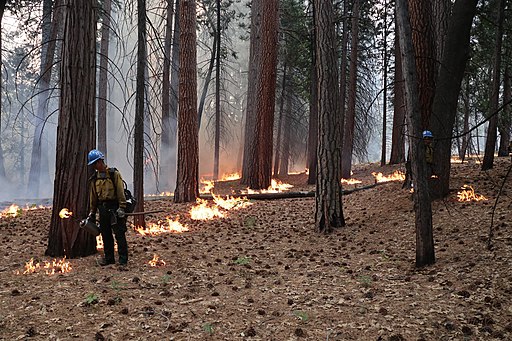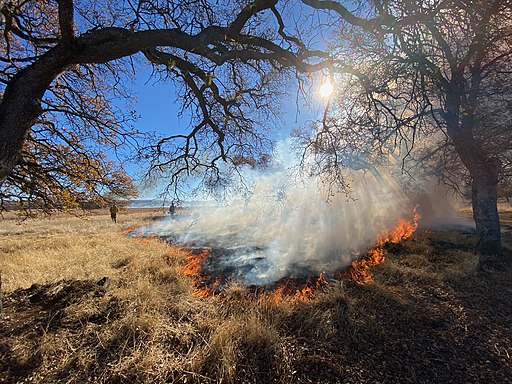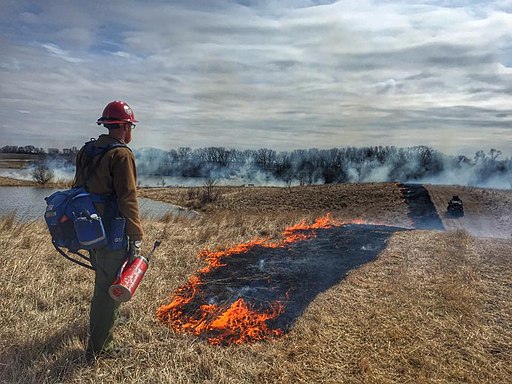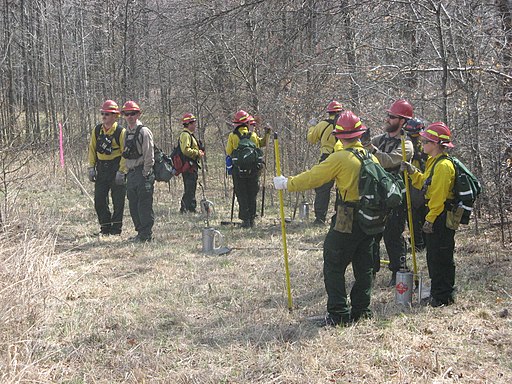Did you know that firefighters use fire to prevent future wildfires or forest fires? This tactic is called controlled burning. But it’s not as simple as just lighting a match. Trained professionals must carefully plan and monitor a controlled burn to ensure they are effective and safe.
Have you ever wondered how controlled burns work or what benefits they provide? In this article, we’ll dive into the ins and outs of this firefighting strategy and explore the many considerations involved in using controlled burns to combat wildfires. From reducing the risk of more dangerous wildland fires to preserving natural habitats, controlled burns play a crucial role in keeping communities and ecosystems safe.

Brave firefighter ignites the forest floor with precision and protecting it from wildfire with the help of a trusty drip torch.
The Fire Triangle
The fire triangle is a concept in fire science that explains the three elements necessary for a fire to exist and burn: fuel, oxygen, and heat.

The Fire Triangle, GRPH3B18, CC BY-SA 3.0 via Wikimedia Commons
In a structural fire, of course, the fire triangle is present in the same way as in any other fire. The fuel for the fire could be any combustible material present in the building, such as wood, paper, or plastic. Oxygen is naturally present in the air, and various sources, such as an electrical malfunction, a lit candle, or a gas leak, can generate the heat for the fire.
For example, if a structural fire were to start in a kitchen due to a faulty stove, the fuel for the fire would be the combustible materials in the kitchen, such as wood cabinetry, paper towels, and plastic utensils. The oxygen necessary would be present in the air, and the faulty stove would generate the heat for the fire.
To extinguish the fire, firefighters must interrupt one or more elements of the fire triangle. This could be done by removing the fuel, such as using a fire extinguisher to spray foam on the flames; by eliminating the oxygen, such as using a smoke inhalation machine to fill the area with an oxygen-depleting gas; or by removing the heat, such as using a fire hose to cool the area with water.

Crews from the Redding Field Office burn 160 acres of overgrown and dead vegetation in the Paynes Creek Wetlands, improving habitats for waterfowl and other animals while reducing wildfire risk.
In a wildfire or a forest fire, the fuel is typically dry vegetation, such as grasses, brush, and trees. Oxygen is naturally present in the air, and the heat for the wildfire can be generated by different sources, such as lightning, a spark from a power line, or a campfire left unattended.
For example, if a wildland fire starts in a grassy field due to a lightning strike, the fuel for the fire would be the dry grasses and brush in the area. The oxygen necessary would be present in the air, and the lightning strike would generate the heat for the fire.
To extinguish the wildfire, as previously mentioned, firefighters must remove one or more elements of the fire triangle. This is where controlled burns come in. Controlled burns can be an effective tool in wildfire management by targeting the fuel element of the fire triangle.
By intentionally setting a controlled burn in an area at risk of a future wildfire, firefighters can reduce the fuel available for a future fire to burn. A controlled burn can help to reduce the likelihood of a future wildfire occurring or at least make it easier to control if one does occur.
Trained professionals consider the weather, wind direction, and other factors that can affect the spread and intensity of the burn.
Benefits of Controlled or Prescribed Burn
What happens in a forest without fire? Without fire, many forests can become overgrown with dense underbrush, leading to increased fuel loads and a higher risk of wildfire. The absence of fire can result in a lack of diversity in plant and animal species. Some species may not survive without the disturbance caused by fire.
One way to address the potential negative impacts of the absence of fire in a forest is through controlled burns.
In the fire service, a controlled burn is also known as hazard reduction burning, controlled fire, prescribed burn, backfire, or counter-fire. It is a process that refers to the intentional setting and careful management of an active fire such as a forest fire, a grass fire, or a wildland fire. Controlled burns can reduce the fuel available for the main fire to consume, making it easier to manage and extinguish.
Controlled burning can effectively reduce the risk of wildfire, promote the growth of certain plant species, and improve wildlife habitat.
Here are some of the benefits of controlled burning:
Reduction of fuel load
One of the main reasons for conducting prescribed burns is to reduce the amount of fuel. For example, the small fire created during a controlled burn is used to burn away dead leaves, brush, and other fuels. This can help prevent fires from becoming more intense and dangerous. By reducing the fuel load, controlled burns can also help protect communities and natural resources from the impact of wildfire.

Controlled burn on the Froland Waterfowl Production Area restores balance to the ecosystem by setting back woody vegetation and protecting native prairie.
Improvement of ecosystem health and biodiversity
Controlled burns can have a number of positive impacts on the ecosystem. They help maintain the diversity of plant and animal life by creating different habitat types, such as grasslands and forests. They can also help control invasive species and promote the growth of native plants. In addition, controlled burns can improve the health of forests and grasslands by reducing the risk of pest outbreaks.
Cultural and historical significance for indigenous communities
For many indigenous communities, cultural burning, have a long history of cultural and spiritual significance. Cultural burning has been around for centuries to manage the land and promote the growth of important plants and animals. In addition, cultural burning or controlled burning can help preserve the traditional practices and knowledge of indigenous communities.
Backfiring Process
Planning and Preparation
Before they conduct a controlled burn, firefighters must take several considerations into account.
- Weather conditions and wind direction. These factors can greatly influence the spread and intensity of the fire.
- Safety of firefighters and the public. Ensuring the safety of all individuals is a top priority. Measures should be taken to minimize the risk of accidents and injuries.
- Impact on air quality and smoke. The smoke produced by a controlled burn can have negative impacts on air quality, particularly for people with respiratory issues.
- Coordination with local authorities and land management agencies. These agencies may have regulations and policies in place that must be followed. It is important to work closely with them to ensure that the burn is conducted safely and effectively.

Firefighters unite to benefit the land and its inhabitants: Controlled burn at Patuxent National Research Refuge helps to improve grassland breeding habitats for birds.
Execution and monitoring
During the burn, it is important to closely monitor the fire and ensure that it stays within the predetermined boundaries. Firefighters and other personnel may be on hand to manage the burn and make any necessary adjustments.
Post-burn evaluation and follow-up
After the controlled burn is complete, firefighters conduct a post-burn evaluation to assess its effectiveness and any impacts it may have had on the environment. This may involve monitoring the burned area for regrowth and tracking any changes in plant and animal populations. Follow-up actions may also be necessary to address any issues identified during the evaluation.

Nature’s renewal: Controlled burn at Portsmouth successfully clears overgrown brush, reducing wildfire risk and rejuvenating the land.
Different forests need different solutions. Not all forests are the same, and effective management strategies in one forest may not be suitable for another. When developing a management plan for a forest, wildland firefighters consider the specific needs and characteristics of that particular forest, including the use of controlled burns. In some cases, controlled burns may be a vital part of a forest management plan. However, alternative strategies may be more appropriate.


